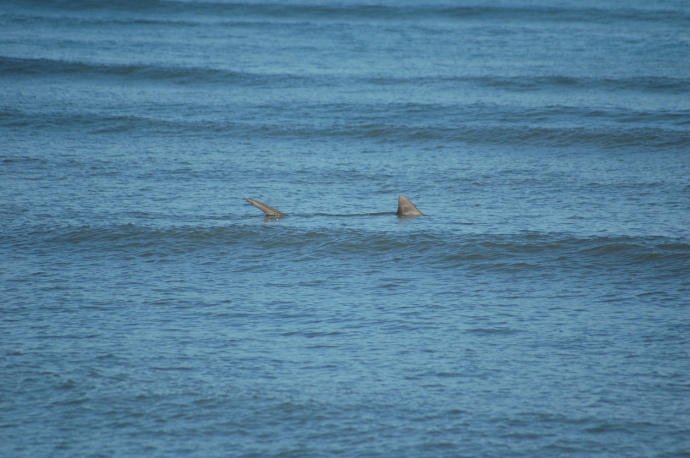Beneath the Surface: Sharks in Perspective

A Maui couple sent in this photo of a shark sighted between 8:50 and 9 am. on Thursday, Aug. 8, 2013 off of Halama Street in Kīhei. DLNR was notified and crews were sent out to patrol the area. Photo courtesy John and Courtney Swanson.
By Wendy Osher
While the presence of sharks in ocean waters is nothing new, a recent encounter in island waters has some paying closer attention to what’s beneath the surface.
According to information posted on the Department of Land and Natural Resources website, authorities say, “It’s important to keep these incidents in perspective, and to remember that in Hawai‘i the chances of being bitten by a shark are less than one in a million.”
“That’s their ʻāina (land), let them be,” said Maui resident Valerie Toro who frequents the north shore of Maui. “They’re not even trying to attack humans,” she said, noting that humans can be mistaken for other ocean-life like turtles.
While encounters, “often generate attention out of proportion to the risk itself,” the DLNR website states, sightings do occur, and Maui Now readers have shared some of their own.
Maui couple, John and Courtney Swanson reported a shark sighting in the Halama Street area of Kīhei between 8:50 and 9 am. on Thursday, Aug. 8, 2013.
According to the Swansons, the DLNR was notified and crews were sent out to patrol the area. The agency also conducted surveillance for about two hours on Aug. 2 in the area of Mākena Landing following a confirmed shark sighting there.
The sightings come on the heels of a shark bite reported at Ulua Beach in Wailea on July 31, 2013. During an interview with the California woman injured in the incident, she said she knows now not to go snorkeling after a storm, in murky waters, or alone.
Some of the tips that frequent ocean goers are familiar with, but those less accustomed to the ocean may not know include the following list of “Safety Dos and Don’ts” published by the DLNR on their agency website. The tips include the following:
- Swim, surf or dive with other people, and don’t move too far away from assistance.
- Stay out of the water at dawn, dusk and night, when some species of sharks may move inshore to feed.
- Do not enter the water if you have open wounds or are bleeding in any way. Sharks can detect blood and body fluids in extremely small concentrations.
- Avoid murky waters, harbor entrances and areas near stream mouths (especially after heavy rains), channels or steep drop-offs. These types of waters are known to be frequented by sharks.
- Do not wear high-contrast clothing or shiny jewelry. Sharks see contrast very well.
- Refrain from excessive splashing; keep pets, which swim erratically, out of the water. Sharks are known to be attracted to such activity.
- Do not enter the water if sharks are known to be present. Leave the water quickly and calmly if one is sighted. Do not provoke or harass a shark, even a small one.
- If fish or turtles start to behave erratically, leave the water. Avoid swimming near dolphins, as they are prey for some large sharks.
- Remove speared fish from the water or tow them a safe distance behind you. Do not swim near people fishing or spear fishing. Stay away from dead animals in the water.
- Swim or surf at beaches patrolled by lifeguards and follow their advice.
Additional information posted on the DLNR website notes that there appears to be an increased risk of being bitten by a shark during certain months, in particular October through December.
“Early Hawaiians recognized this, and cautioned against going in the water at that time. Although fewer people are in the water from November to December, some of Hawaii’s most serious shark attacks took place during those months,” the website states.
In Hawaiian tradition, some sharks were considered ʻaumākua, personal family gods, or deified ancestors, according to the Hawaiian Dictionary (Pukui/Elbert).
“A symbiotic relationship existed; mortals did not harm or eat ʻaumākua (they fed sharks), and ʻaumākua warned and reprimanded mortals in dreams, visions, and calls. (Beckwith, 1970, pp. 124–43, 559; Nānā 38.),” the publication states.
Further information on sharks and safety is posted at a special DLNR page dedicated to shark education.









